Understand the Secrets of Tomato Growth Stages: A Comprehensive Guide
Published: 26 Jul 2024
Tomato plants, regardless of the variety, undergo a fascinating growth process. The life cycle of a tomato plant is a blend of several stages, each with its unique characteristics and requirements. This article will guide you through the six stages of tomato plant growth (germination, seedling, vegetative, flowering, fruit development, and harvesting), offering insights into what you can expect at each phase and how to ensure your plants thrive.
By understanding these stages, gardeners can provide the optimal conditions and care to ensure healthy plants and fruitful harvests.
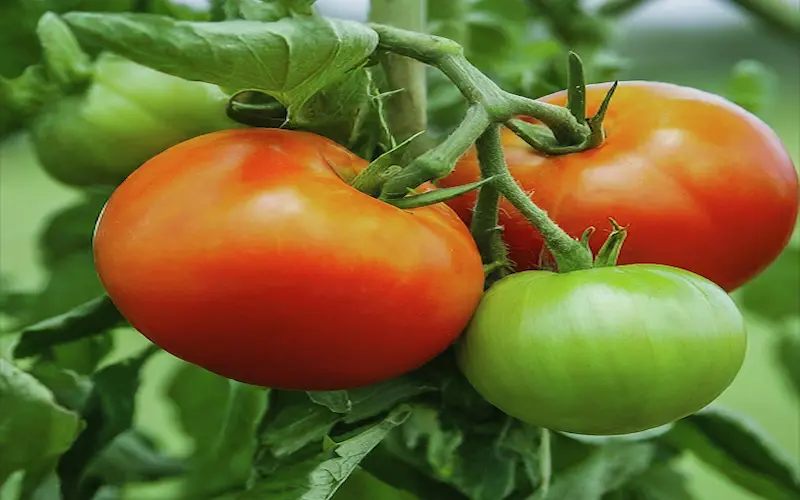
Understanding the Different Stages of Tomato Plant Growth
Like all plants, tomatoes follow a biological roadmap that guides them from seed to fruit. Each stage demands specific environmental conditions and care. The stages of tomato plant growth are not merely a sequence of changes but a series of interconnected events that ensure the plant’s survival and productivity.
While exploring these stages, the timing can vary depending on factors such as tomato variety, climate, and growing conditions. Nevertheless, the fundamental stages remain consistent. By learning these stages, you’ll be better equipped to anticipate the needs of your tomato plants and address any issues that may arise throughout their growth cycle.
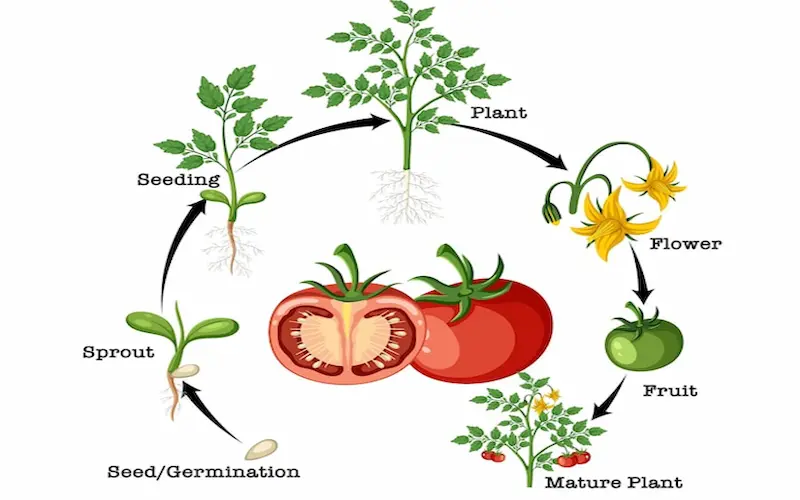
How to Make Tomato Plants Grow Faster
To make tomato plants grow faster, choose the right variety of tomato plants best suited for your climate and region. Provide them ample sunlight (at least 6-8 hours a day), well-draining soil, and proper fertilization. Water your plants consistently and protect them from pests and diseases. Prune your plants to encourage bushier growth and pinch off the suckers to direct more energy to the fruit-bearing branches. Additionally, you can use techniques such as trellising or caging to support the vines and prevent them from sprawling.
Tomato Growth Time Lapse
A tomato growth time-lapse shows the amazing journey of a tomato plant from seed to ripe fruit. In just a few minutes, you can see tiny seeds sprout and grow into small plants. These plants then get bigger and stronger, producing flowers that turn into green tomatoes.
Over time, the tomatoes grow larger and change colour from green to red as they ripen. Watching this process is a fun and fascinating way to see how tomatoes grow and develop.
Germination:
The Start of a New Life
Germination is the critical process that begins life for the tomato plant. It all starts with a seed, an encapsulation of potential. The right balance of moisture, warmth, and air ushers the seed into sprouting. Special care is also necessary for the germination process.
Conditions for Successful Germination
The germination process occurs between 68°F to 78°F (20°C to 25.5°C). I keep my seeds in a warm, moist environment to encourage sprouting. Soil quality is also essential; a light, nutrient-rich mix can make a significant difference. Watering should be done carefully, as overwatering can lead to fungal diseases or seed rot.
The Emergence of the Seedling
The germination stage concludes with the emergence of the cotyledons, or seed leaves. These first leaves are crucial for photosynthesis, providing the energy for the young plant to grow. It takes 5 to 10 days for tomato seeds to germinate. Once the cotyledons appear, the seedling stage begins.
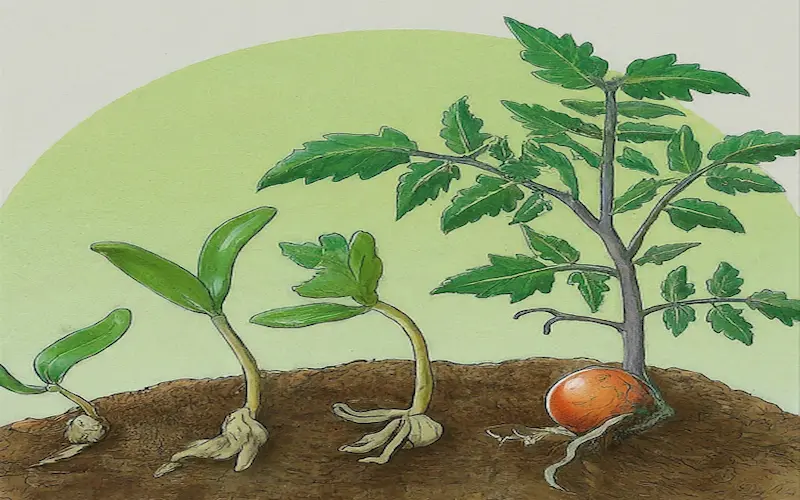
Seedling Stage:
The Importance of the Seedling Stage
The seedling stage is where the plant begins to develop its true leaves. These leaves will eventually make up the bulk of the plant’s foliage. The foundation of the plant’s future growth is established during the seedling stage. Ensuring that the seedling has enough light and nutrients is paramount.
Providing Optimal Nutrition and Light
I’ve found that seedlings need sufficient light to prevent them from becoming leggy and weak. A sunny windowsill or a grow light can provide the necessary illumination. Additionally, I begin to introduce a balanced fertilizer to support their growth. This fortifies the plant, preparing it for the more demanding vegetative stage.
Transplanting Seedlings
As the seedlings grow and develop a set of true leaves, they will outgrow their initial containers. This is the time to transplant them into larger pots or the garden. Transplanting should be done carefully, as the young plants are still quite fragile. I harden off my seedlings before moving them outdoors, gradually exposing them to the elements to reduce transplant shock.
Vegetative Stage:
Rapid Growth and Strengthening
The vegetative stage is characterized by a period of rapid growth. The tomato plant’s stems thicken during this time and foliage increases. This growth spurt requires a lot of energy, so the demand for water and nutrients rises significantly. I pay close attention to the plant’s feeding schedule, ensuring it gets all it needs to build strong structural support.
Training and Pruning
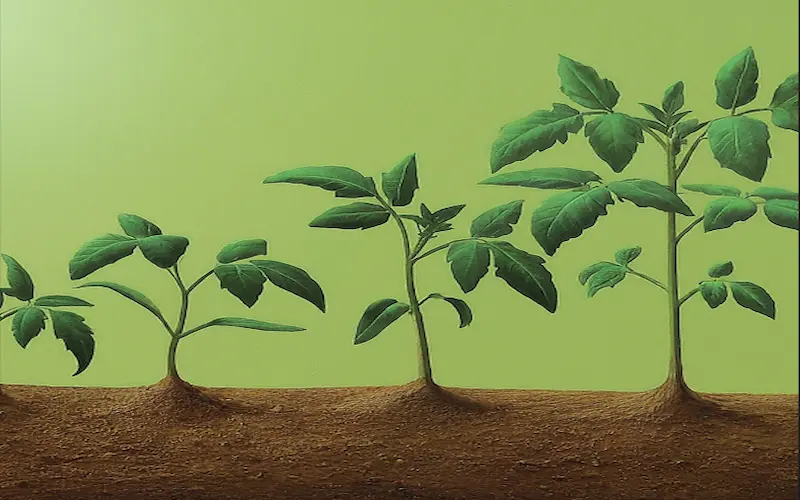
As the plant grows, training and pruning become essential. I typically use stakes or cages to support the plant’s weight and promote air circulation. Pruning, or selectively removing parts of the plant, can help direct energy to the most productive areas. For indeterminate tomato varieties, which grow continuously, I remove the suckers to maintain plant shape and size.
Preparing for the Next Stage
The vegetative stage sets the stage for flowering and fruiting. As the plant matures, I watch for signs that it’s ready to transition to the next phase. This includes a slowdown in leaf production and the development of thicker stems that can support the weight of the fruit. It’s a pivotal moment in the life of the tomato plant as it prepares to reproduce.
Tomato Flowering Stages
The Appearance of Flowers
When the first signs of future tomatoes appear, it is called the flowering stage. The plant produces yellow blossoms, which will eventually become tomatoes. I ensure the plants have less nitrogen, encouraging blooming and more phosphorus and potassium supporting flower and fruit development.
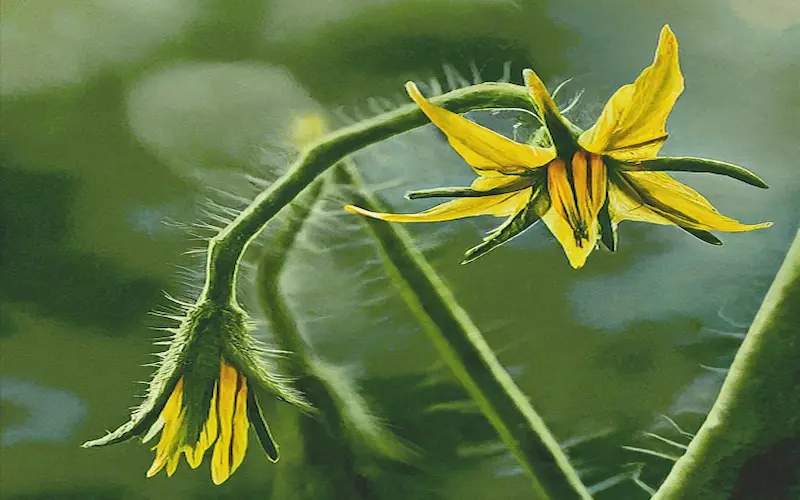
Pollination and Fruit Set
For fruit to set, pollination is essential. While tomatoes are self-fertile, I sometimes gently shake the plants to release pollen or use a small brush. This ensures a higher fruit set, especially in areas with less wind or insect activity. If conditions are too hot or cold, or if humidity levels are off, pollination can be affected, so I monitor the environment closely.
Transition to Fruit Development
After pollinating, the flowers will begin to wither, and tiny green fruits will start to form. It’s a critical juncture where the plant needs consistent watering to prevent stress, which can lead to blossom end rot or fruit cracking. I maintain a steady watering schedule, regularly check soil moisture, and adjust feeding to support the growing fruit.
Fruit Development Stage: Maturation and Ripening Process
Growth and Maturation of Tomatoes
As the fruits grow, they go through a phase of rapid development. It’s a period where I’m vigilant about the plant’s nutrition, as deficiencies can lead to poor fruit quality. The tomatoes will transition from small, green orbs to larger, fully-shaped fruits. I often feel a sense of anticipation during this stage as the first hints of color appear.
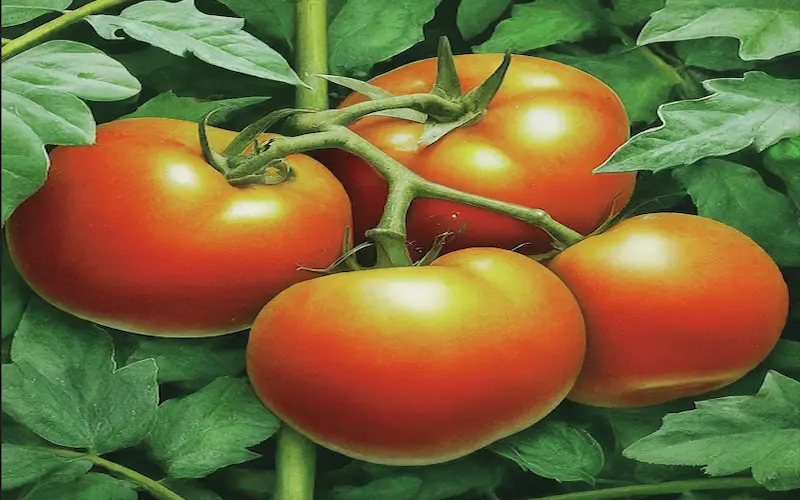
The Ripening Process
Ripening is a complex chemical process that turns the tomato from green to its mature color, whether red, yellow, purple or any other variety-specific hue. This color change signifies the development of sugars and acids, contributing to the tomato’s flavor. I sometimes prune excess foliage to allow more sunlight to reach the fruit, speeding up the ripening.
When to Harvest
As the tomatoes ripen, I watch them closely to determine the best time to harvest. The fruit should be firm but slightly give to gentle pressure. I’ve learned that tomatoes can ripen off the vine, so I sometimes pick them when they change color to avoid issues with pests or overripening on the plant.
Harvesting: Picking Tomatoes at the Right Time
The Joy of Harvest
Harvesting is the most rewarding stage of tomato growth. After weeks of care and attention, I finally picked the fruits of my labor. Harvesting in the morning when the fruit is excellent is helpful to increase its shelf life. Gently twisting the tomato off the vine or using scissors ensures I don’t damage the plant or the fruit.
Storing Your Tomatoes
Once harvested, I store my tomatoes at room temperature, away from direct sunlight. Refrigeration can negatively impact their flavor and texture, so I avoid it unless the tomatoes are fully ripe and I need to slow down the ripening process. Proper storage is critical to enjoying the tomatoes at their peak flavor.
Planning for Continuous Harvest
For varieties that continue to be produced throughout the season, like indeterminate tomatoes, I keep up with maintenance (watering, feeding, and pruning) to ensure a continuous harvest. Regularly picking ripe tomatoes signals the plant to produce more fruit, so regular harvesting is part of the ongoing care.
Common Issues and Challenges During Tomato Growth Stages
Pests and Diseases
Throughout the growth stages, tomatoes can encounter various pests and diseases. From aphids and hornworms to blight and leaf spot, vigilance and early intervention are crucial. I regularly inspect my plants and use organic pest control methods when possible. Proper spacing and crop rotation also help minimize these issues.
Environmental Stress
Environmental factors such as extreme temperatures, inadequate water, or poor soil conditions can stress tomato plants. I mitigate these by providing shade during hot spells, mulching to retain soil moisture, and ensuring the soil is well-draining and rich in organic matter.
Nutritional Imbalances
Nutrient deficiencies or excesses can lead to problems like yellowing leaves or blossom end rot. I use a balanced fertilizer and perform soil tests to maintain optimal nutrient levels. Adjusting the feeding schedule as the plant progresses through its growth stages helps prevent these imbalances.
Tips for Successful Tomato Plant Growth at Each Stage
Starting Strong
Begin with high-quality seeds or seedlings and use a sterile seed-starting mix to prevent disease. Ensure proper depth when planting seeds—usually about 1/4 inch deep.
Vigilant Care
Maintain a regular watering schedule, being careful not to over or under-water. Provide adequate support for your plants as they grow and prune when necessary to promote good air circulation.
Optimizing Conditions
Use mulch to keep the soil temperature stable and retain moisture. Monitor for pests and diseases and take action promptly. Adjust feeding based on the plant’s stage of growth—more nitrogen during vegetative growth and more phosphorus and potassium during flowering and fruiting.
Conclusion:
Understanding the tomato growth stages is akin to unlocking the secrets of nature’s bounty. Each stage, from the hopeful germination to the satisfying harvest, holds its challenges and rewards. You can enjoy a plentiful harvest of juicy, delicious tomatoes by providing the proper care at the right time.

- Be Respectful
- Stay Relevant
- Stay Positive
- True Feedback
- Encourage Discussion
- Avoid Spamming
- No Fake News
- Don't Copy-Paste
- No Personal Attacks



- Be Respectful
- Stay Relevant
- Stay Positive
- True Feedback
- Encourage Discussion
- Avoid Spamming
- No Fake News
- Don't Copy-Paste
- No Personal Attacks




